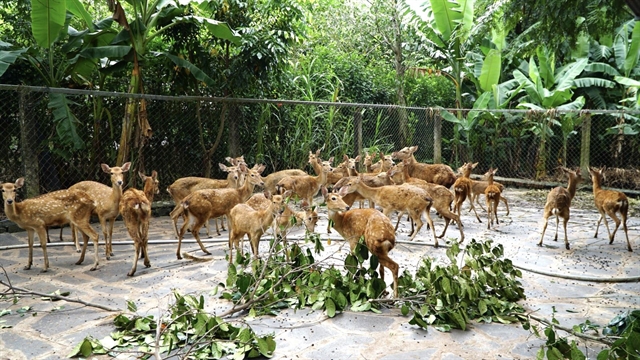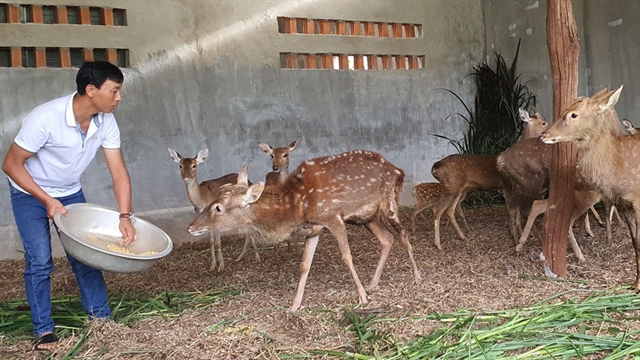 Life & Style
Life & Style

 |
| Deer antler farming and fruit cultivation is a potential job in An Giang. — Photo thanhnien.vn |
AN GIANG — A resident of the Mekong Delta province An Giang has been earning up to VNĐ300 million (US$12,240) a year through deer antler farming and fruit cultivation.
Thới Văn Thảo, born in 1977, from Chợ Mới District, has been in this business for more than two years.
Besides selling antlers, Thảo also supplies breeding deer to the market, generating a stable income of hundreds of millions of đồng per year, significantly improving his family’s financial situation.
Before getting into deer farming for antlers, Thảo had tried various jobs, including cattle raising, farming, and manual labour, but he felt the income was unstable.
After researching, he saw the economic potential of deer farming and decided to sell all his cattle and convert his barn into a deer farm.
To cut costs, Thảo repurposed his old cattle barn into deer enclosures measuring about four metres each.
In early 2023, he visited a deer farm in Tiền Giang Province to learn about antler farming techniques.
After acquiring the necessary skills, he invested in 12 young and mature deer, costing VNĐ25-35 million ($990-1,400) each one, for trial farming.
"Farmed deer rarely get sick, are not picky eaters, and only require chopped banana trunks mixed with a small amount of bran. Besides banana trunks, farmers can feed deers various types of grass and fruits," Thảo explained.
He emphasised that male deer must be kept separately to avoid injuries from fighting each other, which could affect antler quality.
To maintain hygiene, he uses a mixture of rice husk ash and coconut fibre as bedding, replacing it every five to six months.
Male deer typically produce antlers after two years. Each deer yields antlers twice a year, with an average weight of 500-800gr per harvest, and some reaching 1kg.
Dried deer antlers sell for VNĐ25 million per kg and are used in health supplements and traditional medicine.
Thảo also processes fresh antlers into products like honey-infused antlers and antler-infused liquor.
Through persistence and learning, Thảo expanded his farm to 500sq.m with 40 deer, including 18 breeding females and 15 stags producing antlers.
Annually, his farm supplies around 20 breeding deer.
Eighteen-month-old fawns sell for VNĐ18 million each, two-year-old females for VNĐ22-25 million, and stags producing antlers for VNĐ30-35 million.
In addition to deer farming, Thảo also raises fish and grows fruit trees such as coconuts and mangoes. Deer manure is used as fertiliser for the trees.
His combined income from these activities reaches nearly VNĐ300 million per year.
As living standards improve, health-conscious consumers are increasingly seeking deer antlers, while sourcing them from the wild is nearly impossible.
As a result, Thảo’s deer farming model has proven to be a lucrative venture with expansion potential.
Nguyễn Thị Thúy Hậu, head of Agriculture for Chợ Mới District, said that Thảo’s deer farming model is relatively new but economically promising.
The costs are low, deer are resilient to disease, and An Giang’s climate is suitable for their growth, she said.
Additionally, deer are not fussy eaters, and rural areas provide ample food sources like elephant grass, banana trees, and agricultural by-products.
“Many livestock farmers worry about market demand, but deer antlers sell well, often not meeting demand. This model has great potential to be expanded and contribute to rural economic development,” she stated.
Given its advantages, Chợ Mới’s agriculture sector plans to promote deer farming in suitable communes.
The district will collaborate with research institutions to provide technical training for farmers to improve yield and product quality.
To further support Thảo’s deer farming business and boost local income, the district will help develop deer antler products under the OCOP programme, encourage innovation in antler-based products, and promote them at trade fairs, investment conferences, and e-commerce platforms. — VNS




